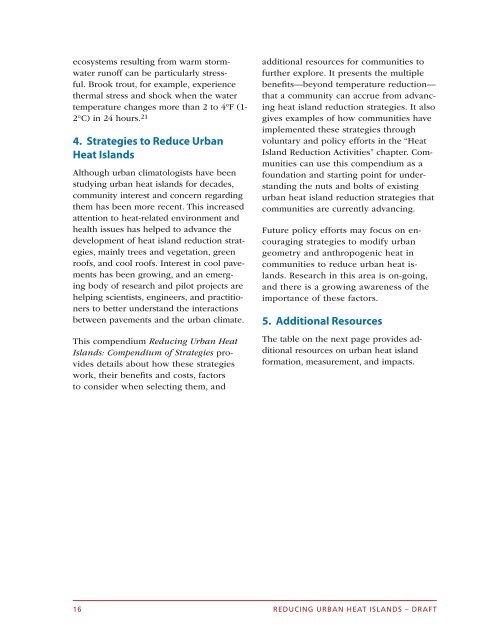Urban Heat Island Basics - US Environmental Protection Agency
Urban Heat Island Basics - US Environmental Protection Agency
Urban Heat Island Basics - US Environmental Protection Agency
You also want an ePaper? Increase the reach of your titles
YUMPU automatically turns print PDFs into web optimized ePapers that Google loves.
ecosystems resulting from warm stormwater<br />
runoff can be particularly stressful.<br />
Brook trout, for example, experience<br />
thermal stress and shock when the water<br />
temperature changes more than 2 to 4ºF (1-<br />
2°C) in 24 hours. 21<br />
4 . Strategies to Reduce <strong>Urban</strong><br />
<strong>Heat</strong> <strong>Island</strong>s<br />
Although urban climatologists have been<br />
studying urban heat islands for decades,<br />
community interest and concern regarding<br />
them has been more recent. This increased<br />
attention to heat-related environment and<br />
health issues has helped to advance the<br />
development of heat island reduction strategies,<br />
mainly trees and vegetation, green<br />
roofs, and cool roofs. Interest in cool pavements<br />
has been growing, and an emerging<br />
body of research and pilot projects are<br />
helping scientists, engineers, and practitioners<br />
to better understand the interactions<br />
between pavements and the urban climate.<br />
This compendium Reducing <strong>Urban</strong> <strong>Heat</strong><br />
<strong>Island</strong>s: Compendium of Strategies provides<br />
details about how these strategies<br />
work, their benefits and costs, factors<br />
to consider when selecting them, and<br />
additional resources for communities to<br />
further explore. It presents the multiple<br />
benefits—beyond temperature reduction—<br />
that a community can accrue from advancing<br />
heat island reduction strategies. It also<br />
gives examples of how communities have<br />
implemented these strategies through<br />
voluntary and policy efforts in the “<strong>Heat</strong><br />
<strong>Island</strong> Reduction Activities” chapter. Communities<br />
can use this compendium as a<br />
foundation and starting point for understanding<br />
the nuts and bolts of existing<br />
urban heat island reduction strategies that<br />
communities are currently advancing.<br />
Future policy efforts may focus on encouraging<br />
strategies to modify urban<br />
geometry and anthropogenic heat in<br />
communities to reduce urban heat islands.<br />
Research in this area is on-going,<br />
and there is a growing awareness of the<br />
importance of these factors.<br />
5 . Additional Resources<br />
The table on the next page provides additional<br />
resources on urban heat island<br />
formation, measurement, and impacts.<br />
16 RedUcING URBAN HeAt IslANds – dRAFt

















